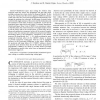Free Online Productivity Tools
i2Speak
i2Symbol
i2OCR
iTex2Img
iWeb2Print
iWeb2Shot
i2Type
iPdf2Split
iPdf2Merge
i2Bopomofo
i2Arabic
i2Style
i2Image
i2PDF
iLatex2Rtf
Sci2ools
CORR
2008
Springer
2008
Springer
Co-ordinate Interleaved Distributed Space-Time Coding for Two-Antenna-Relays Networks
Distributed space time coding for wireless relay networks when the source, the destination and the relays have multiple antennas have been studied by Jing and Hassibi. In this set-up, the transmit and the receive signals at different antennas of the same relay are processed and designed independently, even though the antennas are colocated. In this paper, a wireless relay network with single antenna at the source and the destination and two antennas at each of the R relays is considered. A new class of distributed space time block codes called Co-ordinate Interleaved Distributed Space-Time Codes (CIDSTC) are introduced where, in the first phase, the source transmits a T-length complex vector to all the relays and in the second phase, at each relay, the inphase and quadrature component vectors of the received complex vectors at the two antennas are interleaved and processed before forwarding them to the destination. Compared to the scheme proposed by Jing-Hassibi, for T 4R, while provi...
Antennas | CORR 2008 | Education | Relays | Wireless Relay Network |
| Added | 09 Dec 2010 |
| Updated | 09 Dec 2010 |
| Type | Journal |
| Year | 2008 |
| Where | CORR |
| Authors | Jagadeesh Harshan, B. Sundar Rajan |
Comments (0)

